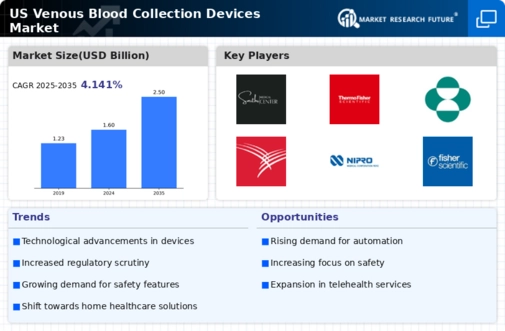Increasing Focus on Patient Safety
Patient safety remains a paramount concern in healthcare, significantly impacting the venous blood-collection-devices market. The emphasis on reducing hospital-acquired infections and ensuring safe blood collection practices has led to the development of advanced blood-collection devices. Regulatory bodies are increasingly mandating the use of safety-engineered devices, which are designed to minimize risks associated with blood collection. This trend is reflected in the market, where safety-engineered devices are projected to account for over 30% of total sales by 2026. Furthermore, healthcare institutions are investing in training programs to educate staff on best practices for blood collection, further enhancing patient safety. As a result, the focus on patient safety is likely to drive innovation and growth within the venous blood-collection-devices market.
Rising Demand for Diagnostic Testing
The venous blood-collection-devices market experiences a notable surge in demand due to the increasing prevalence of chronic diseases and the need for regular diagnostic testing. As healthcare providers emphasize early detection and preventive care, the utilization of blood tests has become more prevalent. According to recent data, the diagnostic testing market is projected to grow at a CAGR of approximately 6.5% through 2027. This growth directly influences the venous blood-collection-devices market, as more tests necessitate efficient and reliable blood collection methods. Furthermore, the expansion of outpatient services and home healthcare is likely to drive the demand for user-friendly blood-collection devices, enhancing patient comfort and compliance. Thus, the rising demand for diagnostic testing significantly propels the growth of the venous blood-collection-devices market.
Expansion of Home Healthcare Services
The expansion of home healthcare services is reshaping the landscape of the venous blood-collection-devices market. With an increasing number of patients opting for home-based care, there is a growing need for portable and easy-to-use blood-collection devices. This trend is particularly relevant for patients with chronic conditions who require regular monitoring. The home healthcare market is anticipated to grow at a CAGR of approximately 7% through 2028, indicating a substantial opportunity for manufacturers of venous blood-collection devices. Additionally, the convenience of home testing is likely to enhance patient compliance and satisfaction. As healthcare systems adapt to this shift, the demand for innovative blood-collection solutions tailored for home use is expected to rise, thereby driving growth in the venous blood-collection-devices market.
Technological Innovations in Blood Collection
Technological advancements play a crucial role in shaping the venous blood-collection-devices market. Innovations such as automated blood collection systems, safety-engineered devices, and advanced materials are enhancing the efficiency and safety of blood collection procedures. For instance, the introduction of devices that minimize the risk of needlestick injuries has become increasingly important in clinical settings. The market for safety-engineered devices is expected to witness a growth rate of around 8% annually, reflecting the industry's commitment to improving safety standards. Additionally, the integration of digital technologies, such as mobile applications for tracking blood collection, is likely to enhance user experience and streamline workflows. These technological innovations not only improve the quality of care but also contribute to the overall growth of the venous blood-collection-devices market.
Regulatory Changes and Compliance Requirements
Regulatory changes and compliance requirements significantly influence the venous blood-collection-devices market. As healthcare regulations evolve, manufacturers must adapt their products to meet new standards, which can drive innovation and improve device safety. The FDA and other regulatory bodies are continuously updating guidelines related to blood collection devices, emphasizing the need for safety and efficacy. Compliance with these regulations is essential for market entry and can impact product development timelines. Moreover, the increasing scrutiny on medical devices is likely to encourage manufacturers to invest in research and development to ensure their products meet the latest standards. Consequently, regulatory changes may create both challenges and opportunities within the venous blood-collection-devices market.



















Leave a Comment